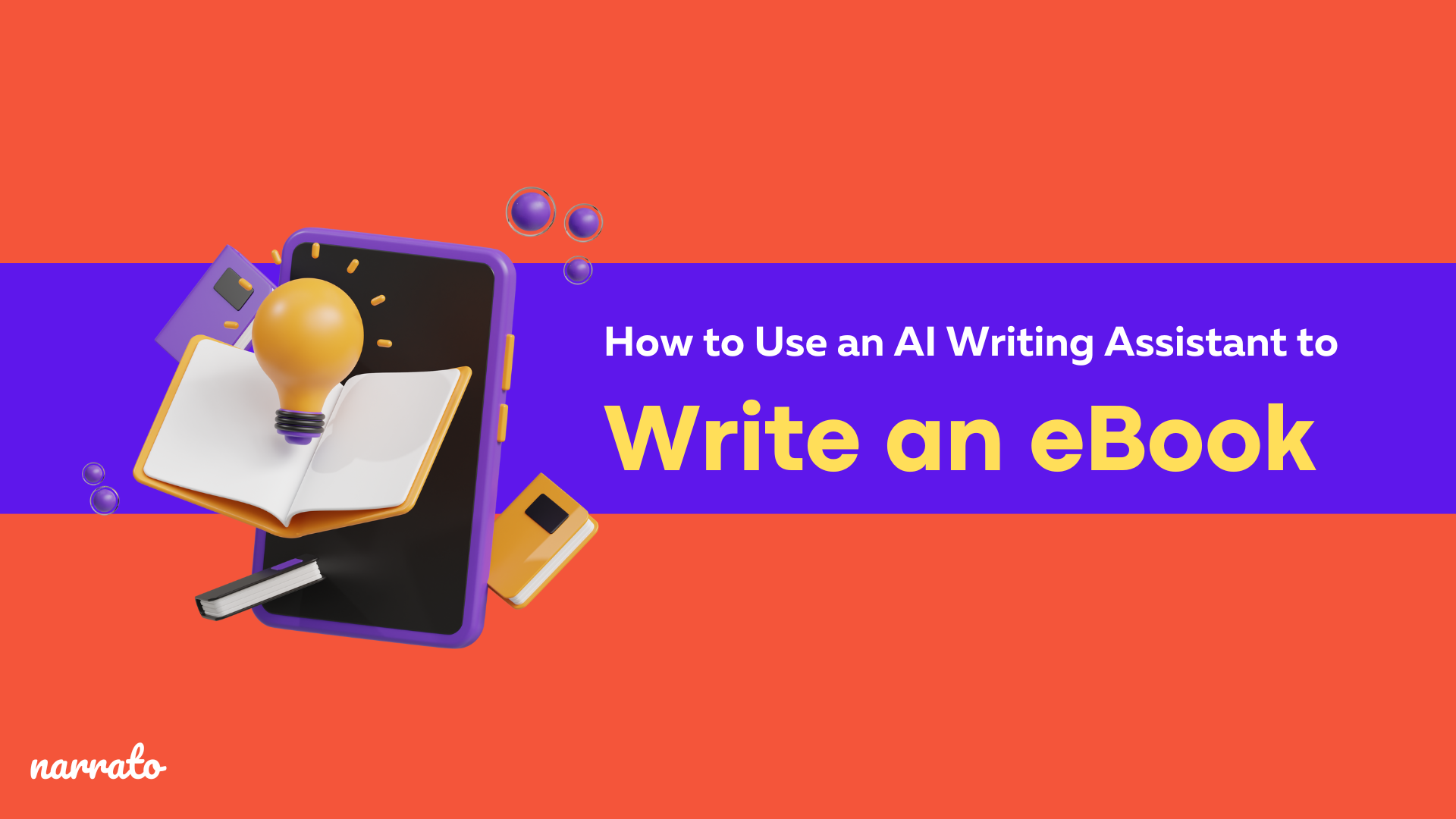eBook writing often takes weeks or even months, involving multiple stages like brainstorming, outlining, drafting, revising, and formatting. If you’re short on time but eager to publish, an AI writer can speed up the process. It can help turn your scattered thoughts into a well-organized eBook packed with valuable insights. This article will guide you on using AI to write and publish your book faster and more efficiently. Let’s get started. 👏
How to use AI writing assistants for eBook writing
- Use the AI topic generator to come up with an eBook title
- Generate an eBook outline with AI’s help
- Generate chapter outlines and content using AI
- Design your eBook with AI images
- Make any final edits

What is an eBook?
An eBook, short for electronic book, is a digital version of a physical book that you can read on various devices like e-readers, tablets, smartphones, and computers. Unlike traditional paper books, eBooks are versatile, portable, and can be distributed with much more ease and far less expense.
Why write an eBook, you ask? Many writers, entrepreneurs, educators, and marketers see writing an eBook as a powerful way to share expertise, educate others, and establish their credibility in a subject area. Take, for example, this eBook on Scale Your Online Business with Conversion Funnels from marketing strategist, Neil Patel. This resource is designed to teach readers how to set up and grow their online businesses effectively. To download it, users would be required to fill out a contact form as well, so this eBook helps in lead generation too.

Here are some other reasons why you can consider creating eBooks –
- eBooks can be a powerful marketing tool to promote your services and products. It can also be used as gated content for lead generation.
- In eBooks, you can interactive elements like links, audio, and video, and enhance reader experience and engagement.
- Ease of publishing. Self-publishing an eBook can be simpler and faster compared to navigating the world of traditional publishing.
- Digital distribution allows your book to travel the world without the need for shipping.
Writing an eBook can be a rewarding venture, both intellectually and potentially financially, especially when you use modern tools like AI writing assistants to streamline the process. In the next section, we’ll show you exactly how this works.
How to use AI writing assistants for eBook writing
Using an AI writing assistant can make eBook writing much easier and faster. From ideation to the final draft, AI can help at every step of the way. Here’s a quick guide on creating an eBook with an AI writing assistant –
Step 1. Use the AI topic generator to come up with an eBook title
Selecting the right title for your eBook is a crucial step in the writing process, as it sets the tone for what’s ahead. Your title serves as the first impression of your work and can often be the deciding factor in whether someone will take the next step to explore further. Give some thought and care in coming up with an eBook title, and it will help build excitement and a strong connection with your readers from the very beginning.
If you need a little help in coming up with creative ideas for eBook titles, use an AI topic generator. Just input a few words related to your subject, and watch the magic happen. You’ll get a list of eBook title suggestions that would go perfectly with the content of your book.
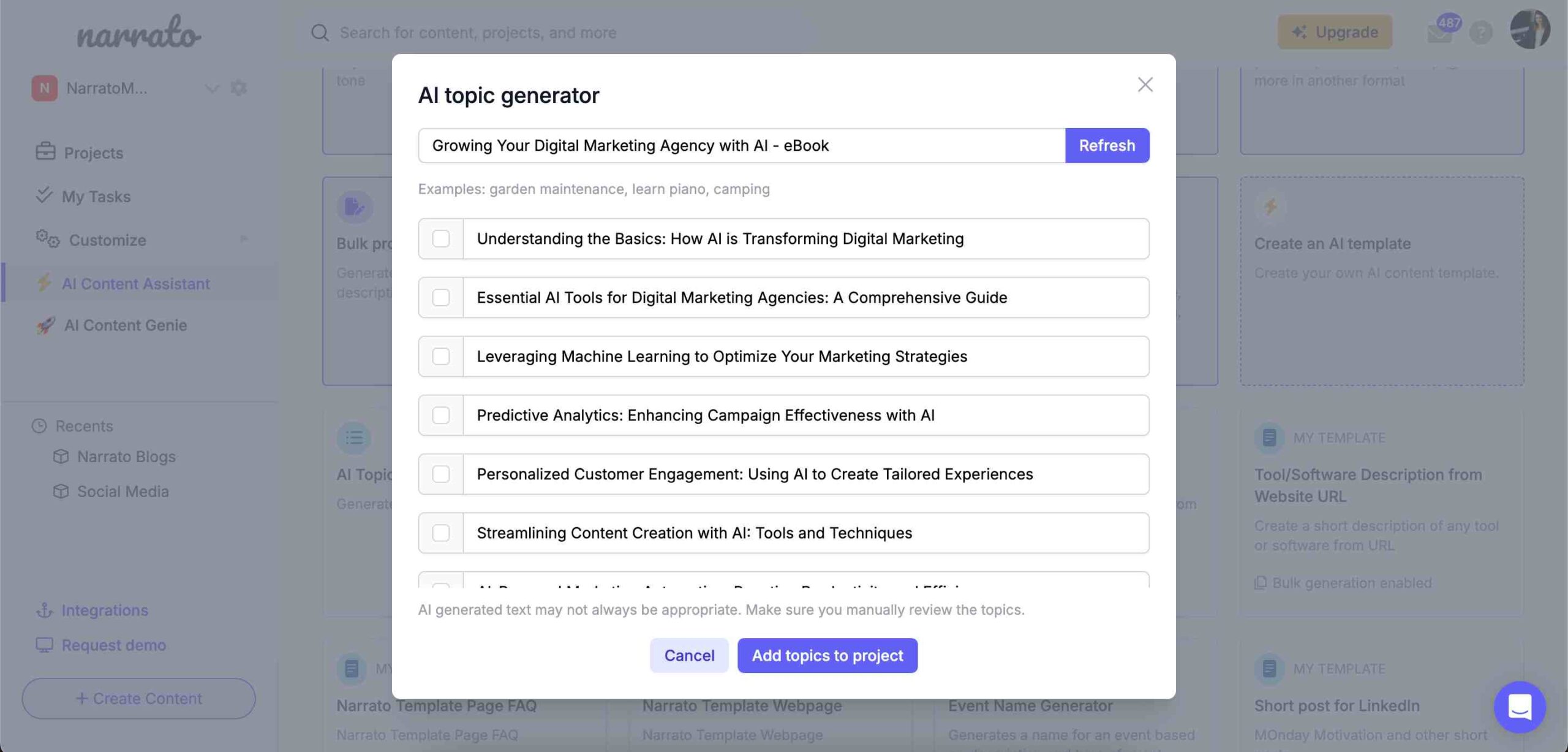
💡 Here’s a tip: When you have a clear idea of your eBook’s focus, using AI to generate titles can be a great starting point (just like we’ve done here). However, there are times when you’ll need to begin writing your eBook before you can determine its direction. In such cases, it’s wise to save choosing the title for the end.
Step 2. Generate an eBook outline with AI’s help
Once you’ve settled on a topic, the next step is constructing an outline for the complete eBook. This will help guide your writing process and ensure that you cover all the essential points systematically. If you have a clear idea about what you want to write, you can start by dividing the eBook into chapters or sections, each dedicated to a specific aspect of your topic.
An AI writing assistant can also generate a comprehensive structure for your eBook. On Narrato’s AI Chat tool, you would simply have to input a ChatGPT prompt explaining your eBook topic and what you require. Using that information, the AI will suggest a logical flow and important subtopics to cover. This might include:
- Introduction
- Key concepts
- Case studies or real-life examples
- Practical tips
- Conclusion
This is what it might look like 👇
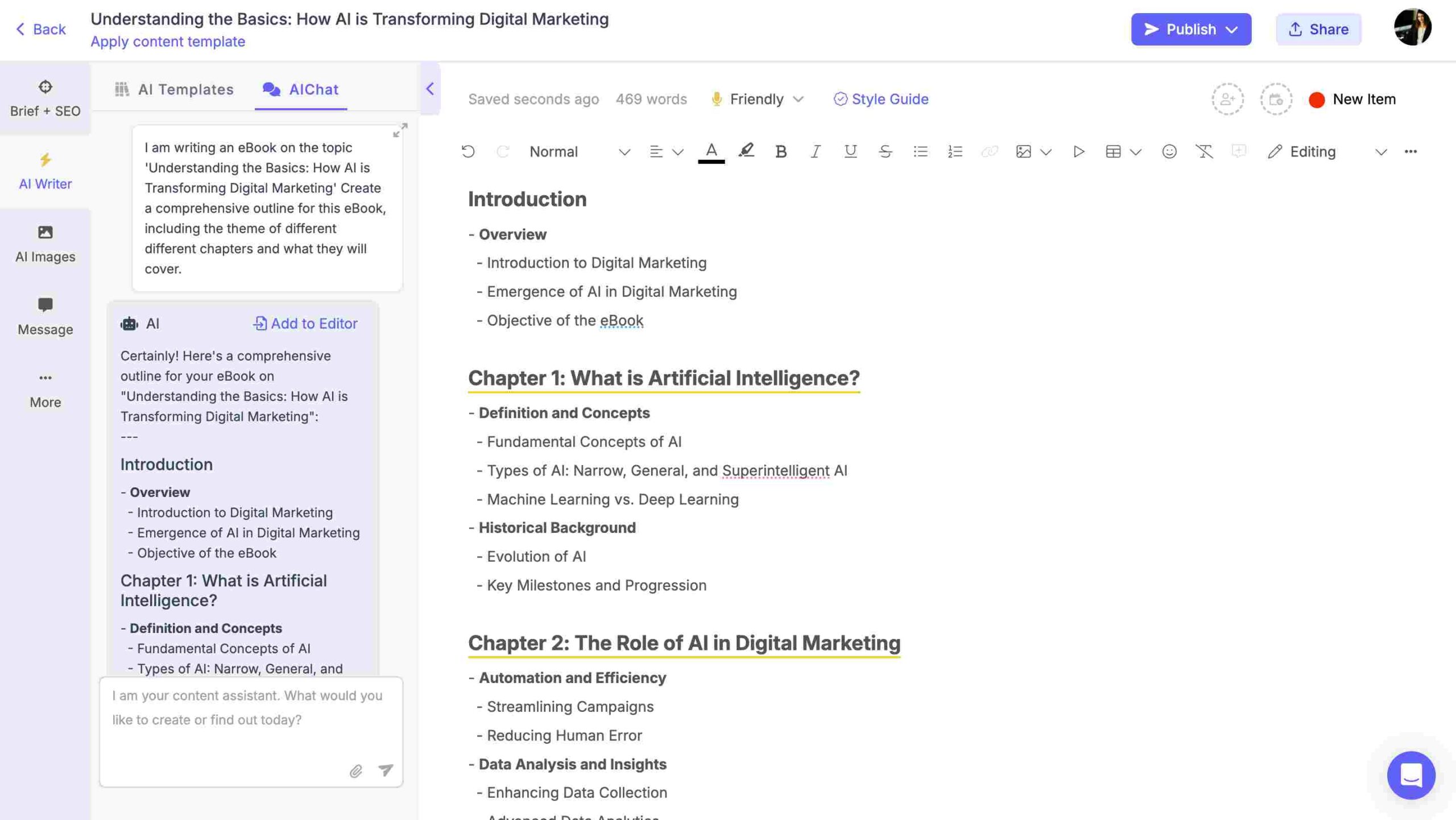
You can adjust this eBook outline however you want, adding and removing sections as necessary.
With a solid outline in hand, you’ll find that writing your eBook becomes a more streamlined and enjoyable experience. Plus, it will help you stay on track and produce a well-organized, cohesive manuscript that your readers will appreciate.
Step 3. Generate chapter outlines and content using AI
The complete eBook outline will give you an idea of the topics to cover in each chapter, but it’s also beneficial to create a detailed content outline for each chapter individually. Each chapter’s outline should include :
- An opening statement that hooks the reader
- A series of well-defined sections, each with a main point or objective
- Bullet points under each section for detailed discussions
- A summary or a teaser for the next chapter to retain reader engagement
Once you have this outline, you can start your eBook writing.
Narrato’s AI article writer combines both outline and content generation in one tool. This means you can generate your outline, and prompt the AI to start drafting the content based on those outlines. Here’s how it works –
👉 First, navigate to the AI writer tab and click on the AI Long Blog Article template
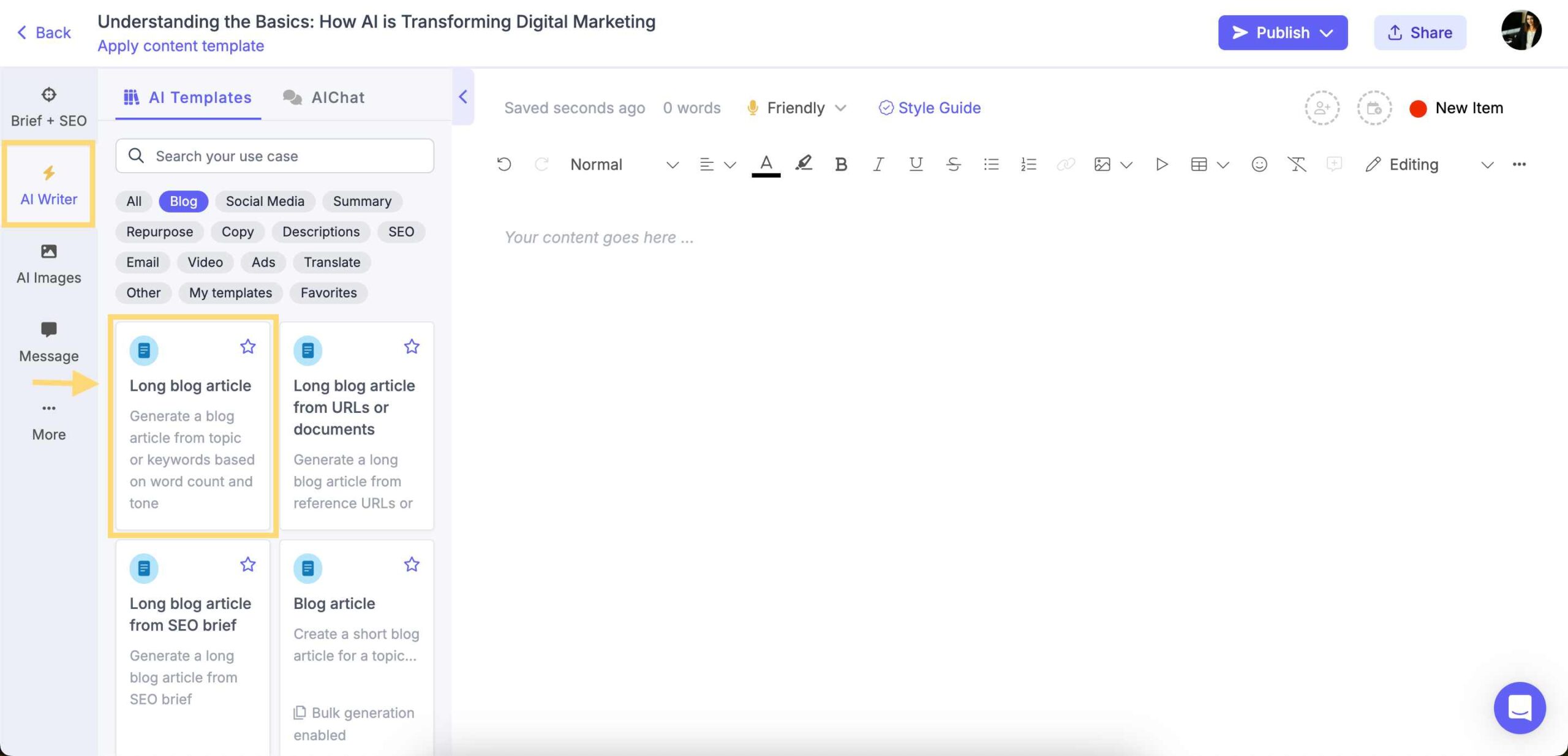
Input the topic of the first chapter in the relevant field.
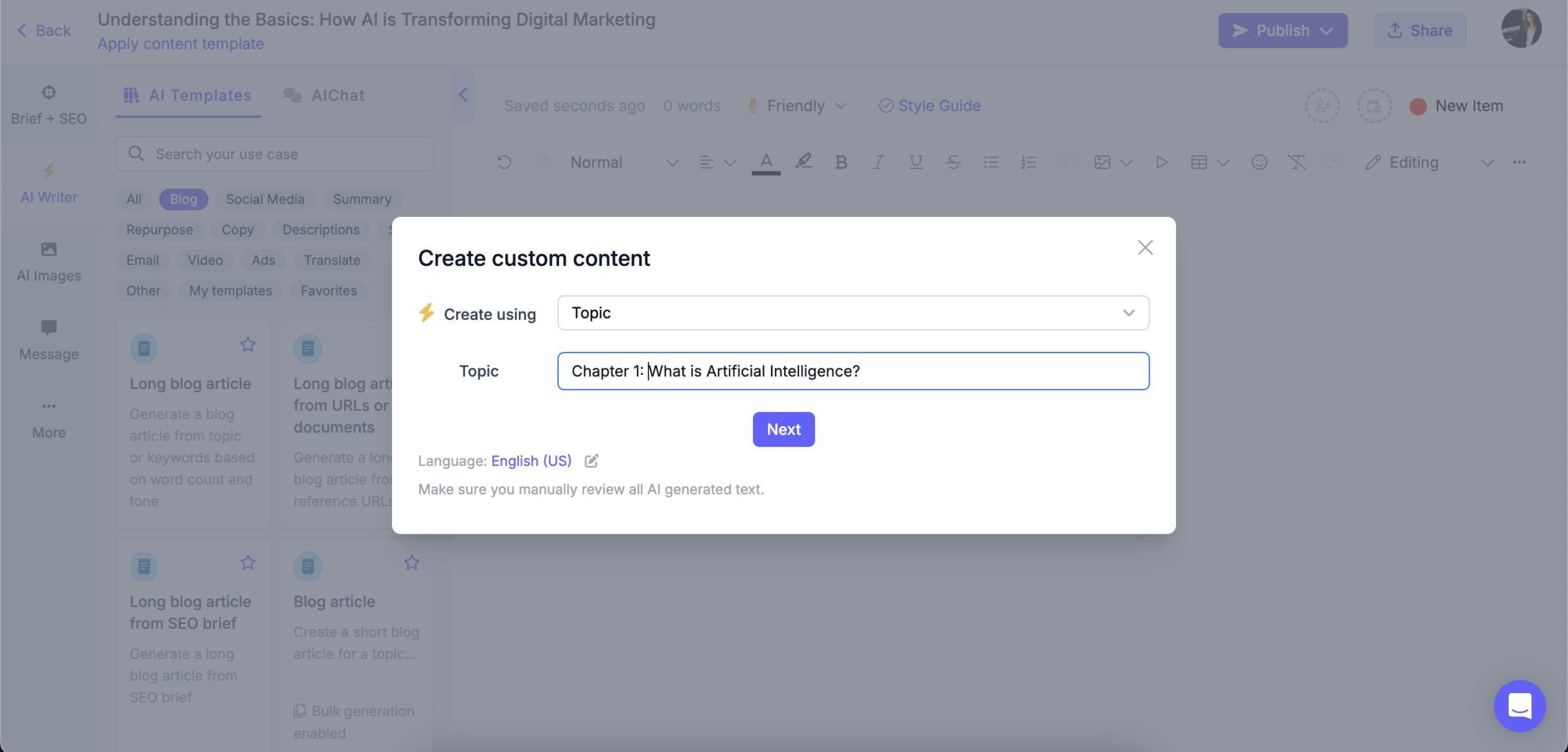
Based on this topic, the AI will generate a content brief, with relevant keywords and recommended length. It will also create a content outline, with all the headings and subheadings for that chapter. Edit this outline as required, and you can also adjust the other elements of the eBook (the length, tone, keywords, etc.).
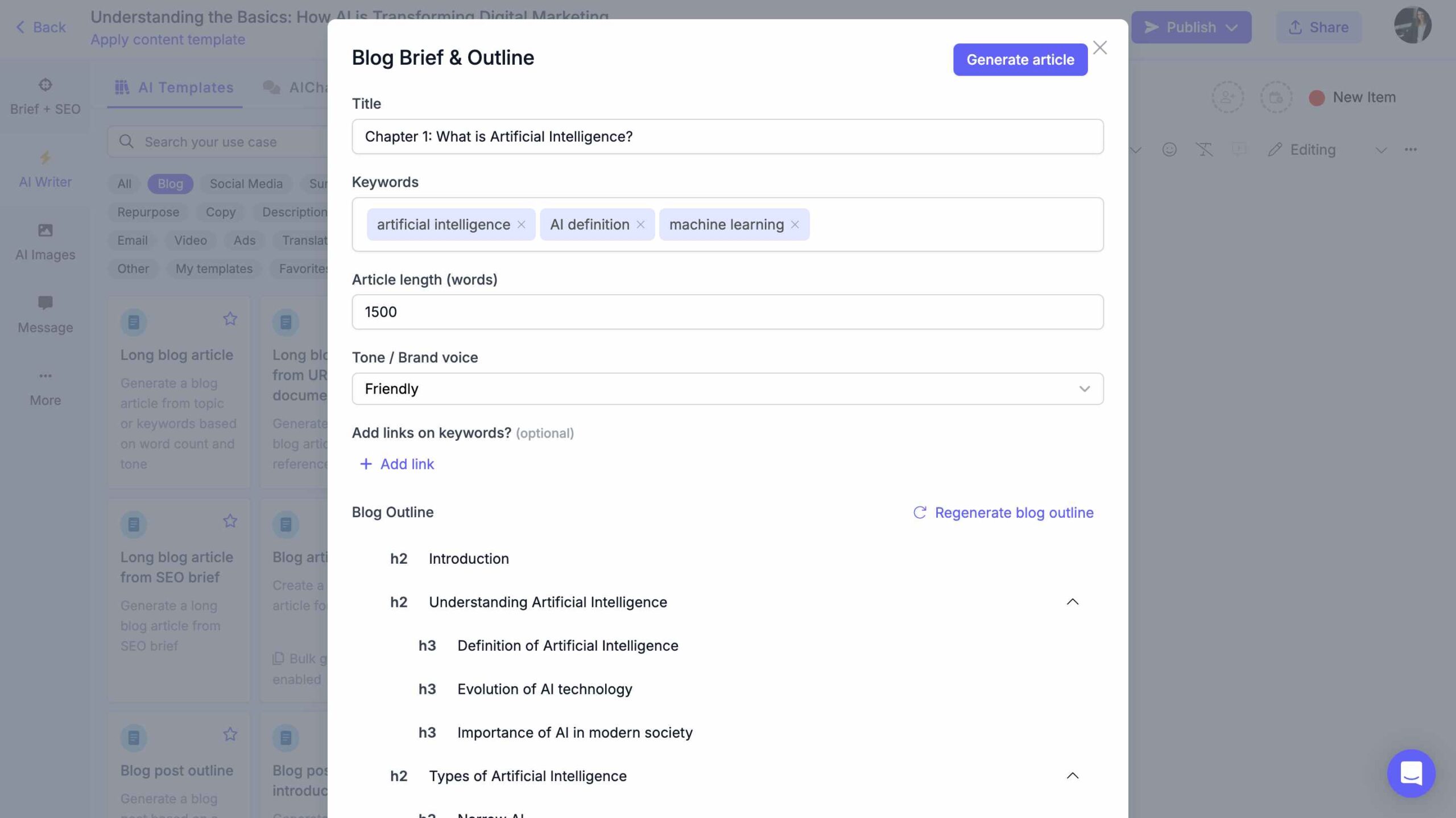
Once you’re done, click ‘Generate.’
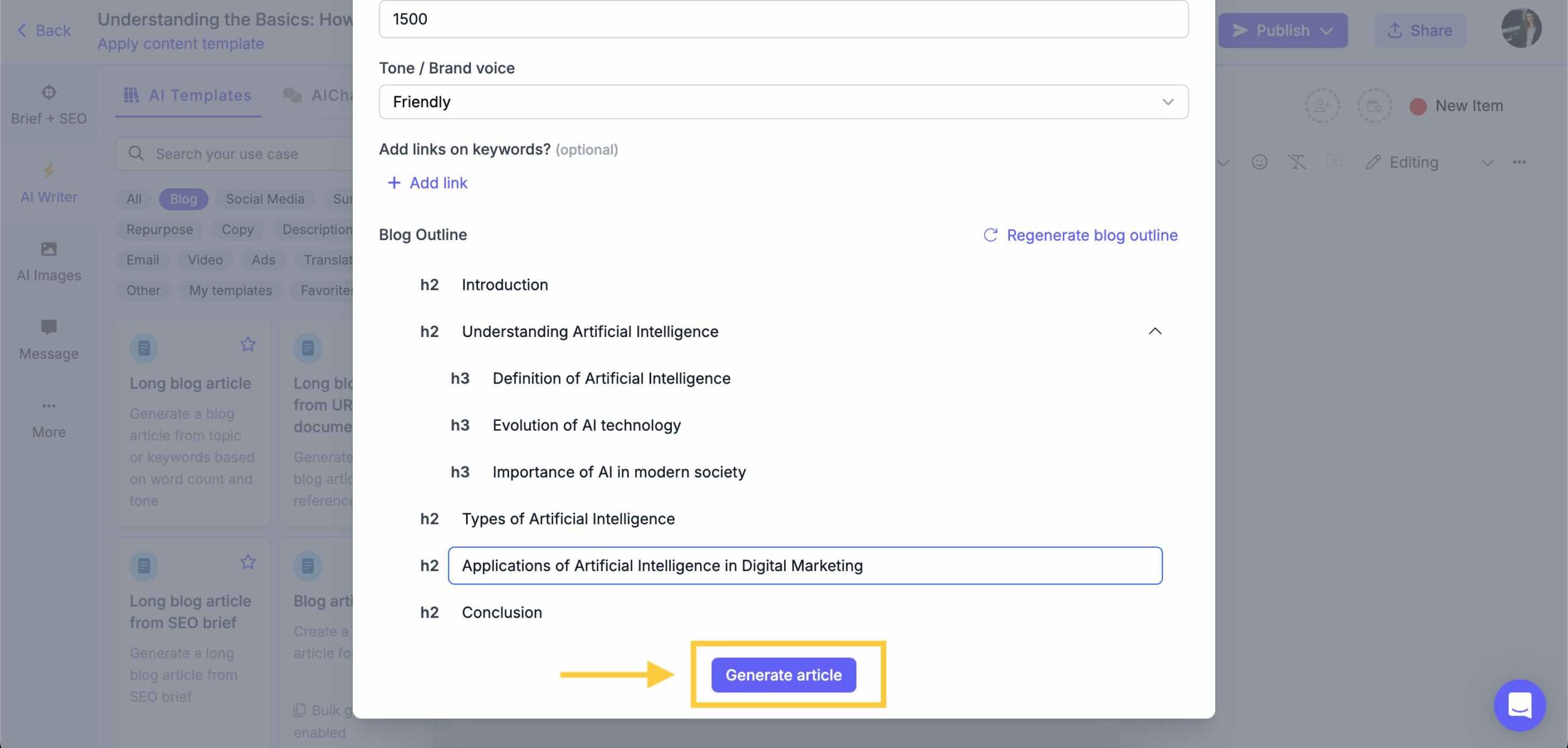
The AI will generate eBook content based on that outline, even adding relevant images to accompany the text.
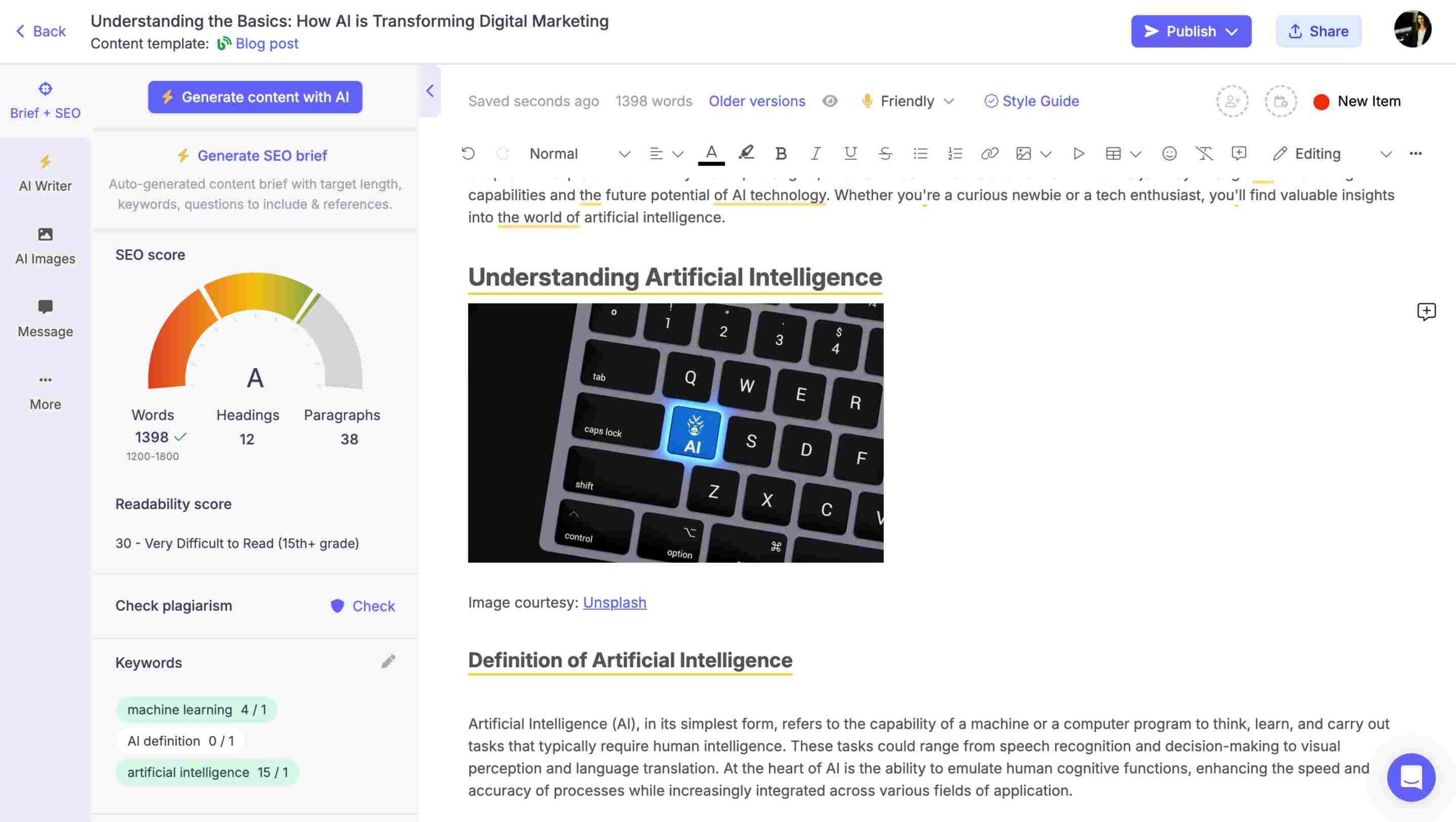
You can repeat this process for each chapter until you have all the content to compile the complete ebook.
For writing the foreword, author bio, and any other content for your eBook, you can create custom AI templates on Narrato.
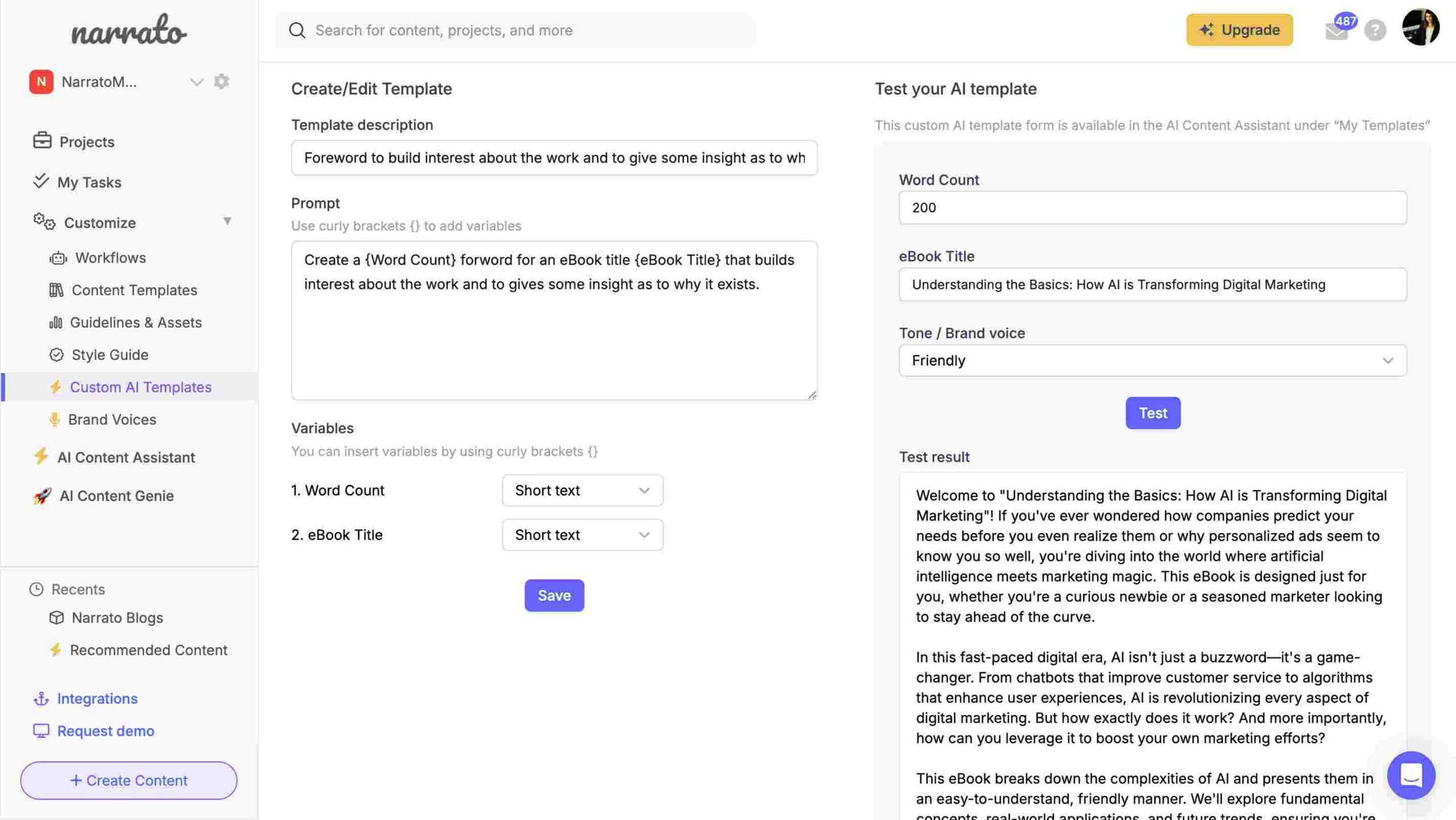
Step 4. Design your eBook with AI images
Designing your eBook with AI images can elevate its look and feel, making it more engaging and visually appealing. A good AI image generator can help create custom images tailored to your book’s content. Whether you need a striking cover or unique illustrations for each chapter, these tools can generate high-quality visuals in minutes. Just input a brief description, and voilà! You’ve got graphics that match your vision.

Check out this compilation of AI image prompts to find some useful prompts for generating AI images for eBooks.
Using AI images ensures your eBook stands out with original content, avoiding the pitfalls of stock photos. You can also incorporate QR codes using The QR Code Generator, allowing readers to easily access supplementary online resources, or videos. It’s a game-changer for anyone looking to create a professional, polished eBook. For added flexibility, use a dynamic QR code generator as it lets you update links even after the eBook is published.

5. Make any final edits
Before you hit publish, go over your eBook content with a fine-tooth comb and –
- Review for any inconsistencies or factual errors
- Ensure the voice and tone remain consistent throughout
- Double-check that all graphical elements are correctly positioned and error-free
- Use AI tools for a final grammar and spell-check
If you want to rework certain sections, you can take the help of Narrato’s in-line AI writing assistant. This has options like Content Improver, Simplify, Shorten, Expand, Rewrite, Grammar Correction, and more to help enhance the quality of your content.
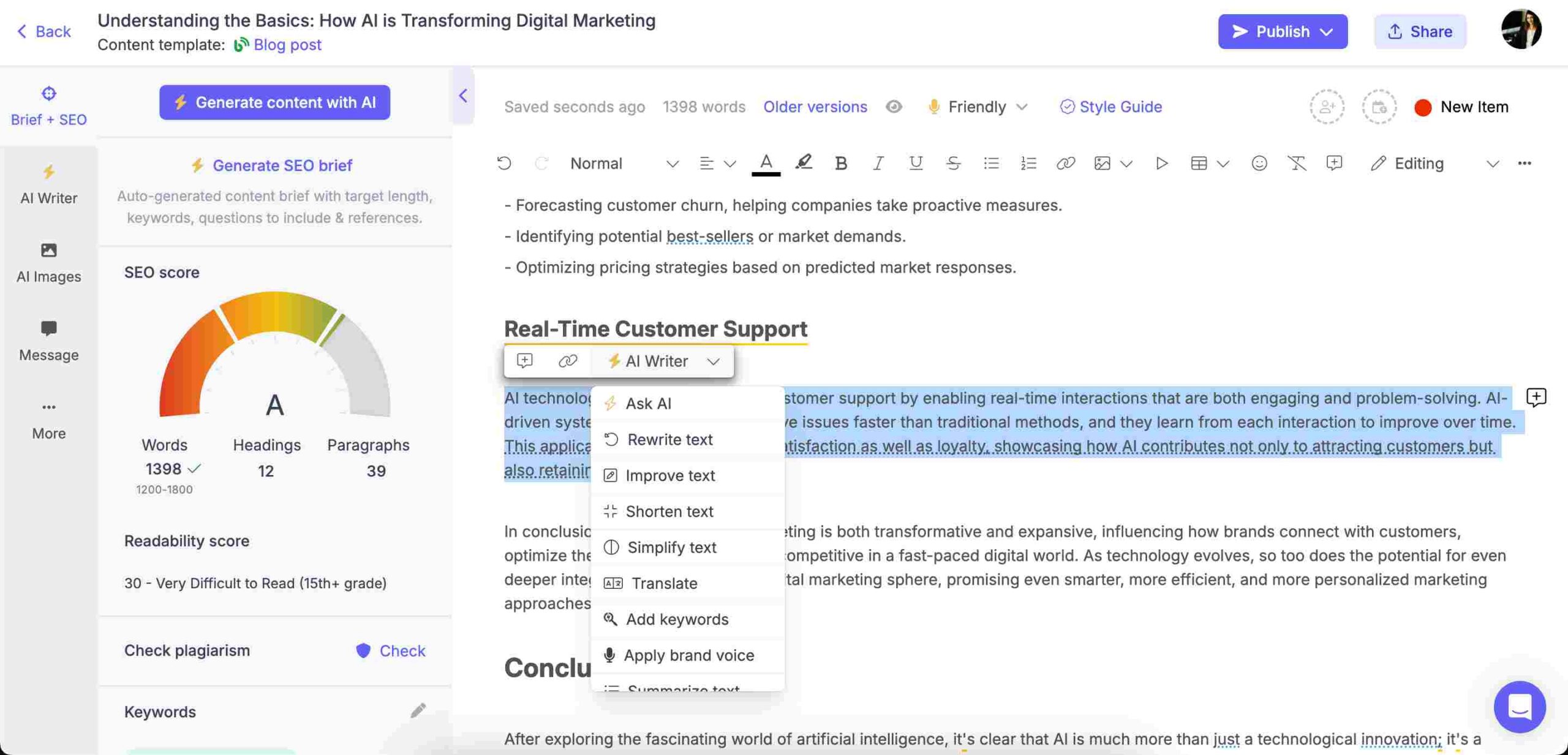
Making these final edits is essential to ensure your eBook is polished and ready to make a great impression on your readers.
Tips on writing a good eBook
To ensure the success of your eBook, these are some essential tips to keep in mind throughout the writing process.
1. Gather all your existing material for the eBook
Before you start writing your eBook, collect all the existing material that relates to your eBook’s topic. Chances are that you might have some of this material already, whether in the form of blog posts, articles, notes, presentations, or relevant research findings. Organizing this material can provide a solid foundation for your outline and help ensure that no critical information is overlooked. Use tools like digital folders or note-taking apps to keep everything accessible and sorted by categories or chapters.
2. Write a strong introduction
A captivating introduction sets the stage for your eBook and hooks your readers right from the start. Start with a compelling question, a shocking fact, or a relatable anecdote that draws readers in. Clearly state the purpose of your eBook and what they will gain by reading it. Consider sharing a bit of your personal journey or passion for the topic to build a connection. Remember, the first few paragraphs should engage, inform, and intrigue your audience enough to continue reading. Your goal is to make them feel invested and eager to dive into the content you’ve carefully crafted.
3. Provide unique insights that are not readily available elsewhere
To stand out in a crowded market, offer unique insights, data, and fresh perspectives on your topic. Conduct original research, interview experts, or use case studies to provide data and information that readers can’t find easily elsewhere. This will increase the perceived value of your eBook, making it more appealing to your audience. Remember, the more exclusive your content, the more likely it is to get noticed and shared.
4. Maintain consistent formatting
Consistency in formatting not only contributes to a professional appearance but also improves readability. Use a consistent font style, size, and color throughout your text. Headers, subheaders, bullet points, and images should all follow a uniform style. Additionally, ensure that paragraphs are evenly spaced and margins are aligned. Using an eBook template or referring to well-formatted eBooks can help guide your styling choices.
5. Design a professional-looking eBook cover
The cover is often the first impression your eBook makes, so invest in a high-quality, professional design that reflects the content inside. Your cover should catch the eye while also being relevant to the topic at hand. If you’re not a designer yourself, consider hiring a professional or using online cover design tools like Canva and Pixlr. These tools come with pre-made templates for designing your eBook covers. Don’t forget, your cover image needs to look good at a smaller size since many readers will first see it as a thumbnail.
6. Promote your eBook
Once your eBook is published, promotion is key to its success. Leverage your existing platforms like social media, blogs, and email lists to announce your release. You can create engaging posts, write teasers or blogs about topics related to your eBook, and encourage shares and comments to increase visibility.
In closing
By following the strategies outlined in this article, you can craft a great eBook with the help of an AI writing assistant. It’s important to understand your audience’s needs and how to best meet them. Combining this approach with the efficient use of an AI writing assistant can make the eBook creation process smoother and improve the quality of your content.
Embracing AI in your writing process can lead to astonishing results and possibly, a bestseller eBook in your portfolio! Try Narrato AI for eBook writing today!


